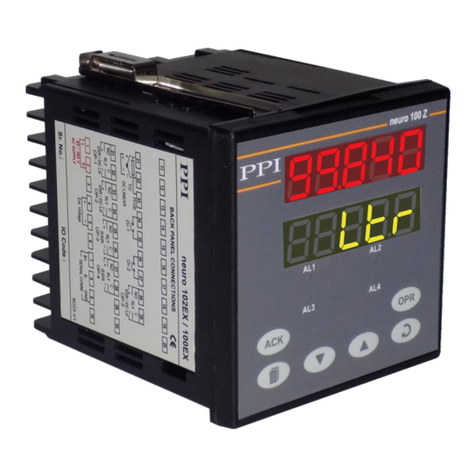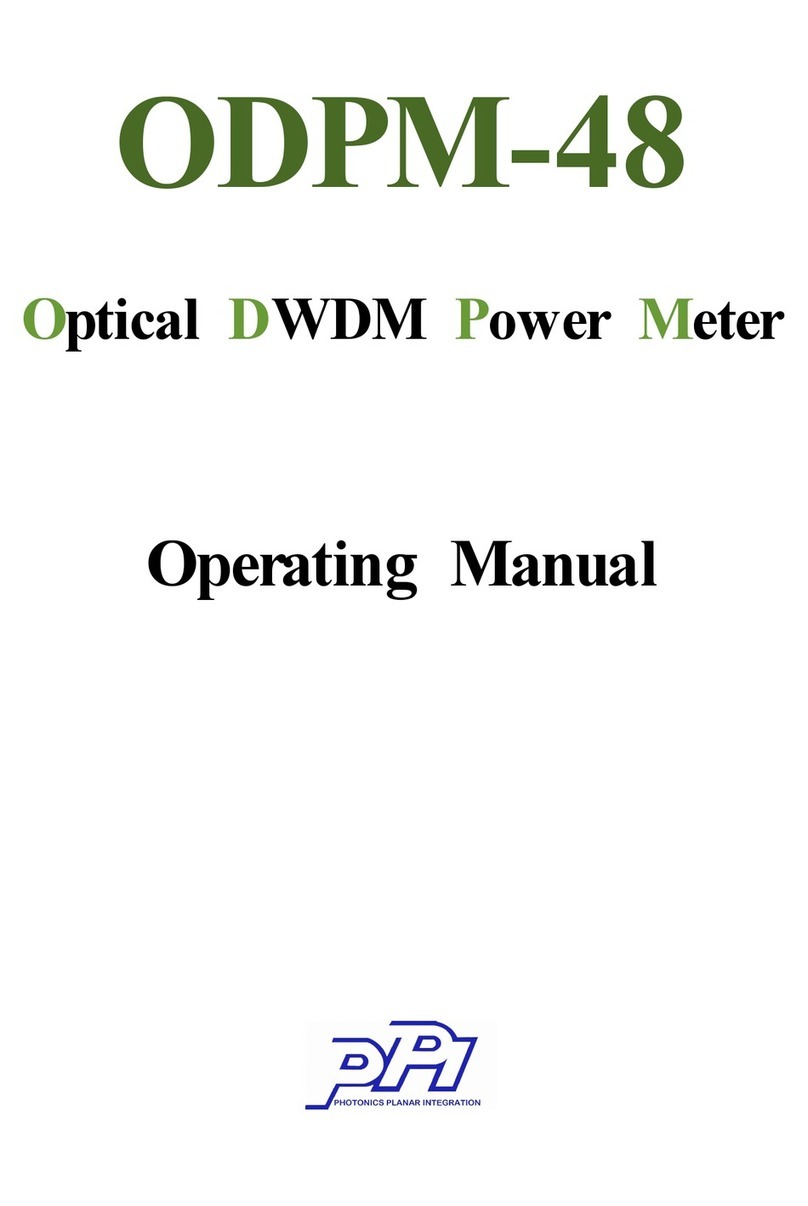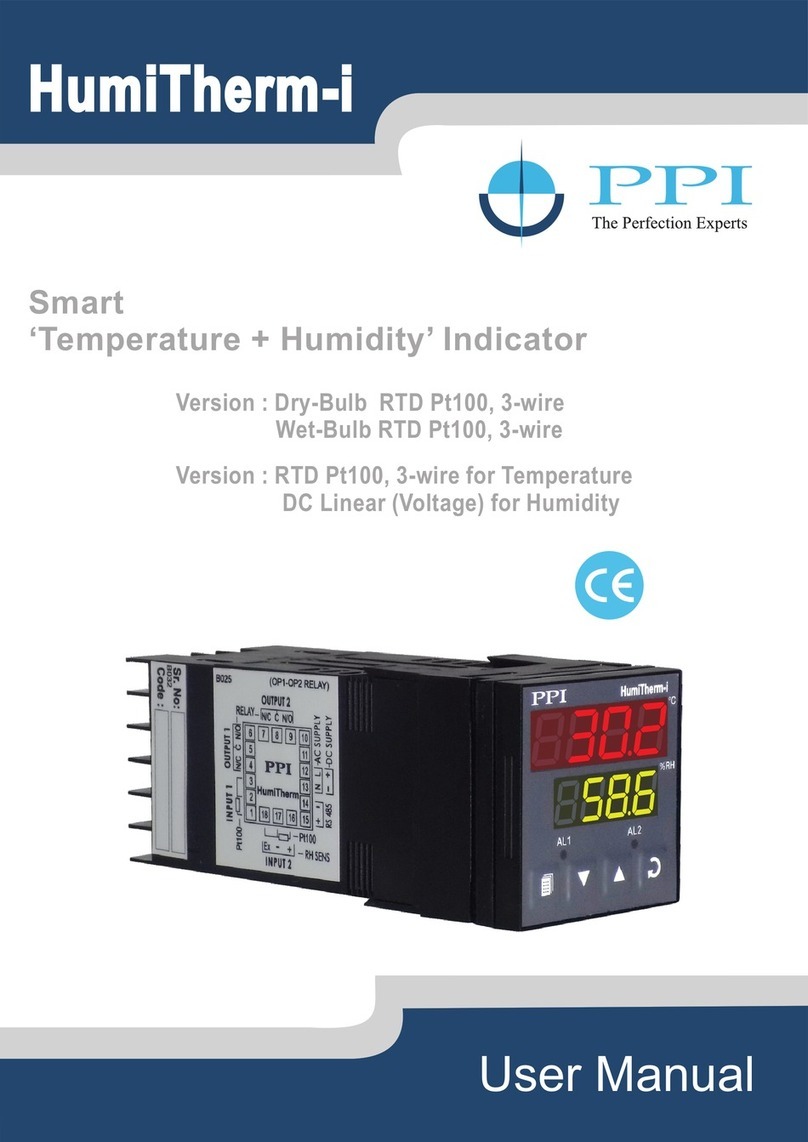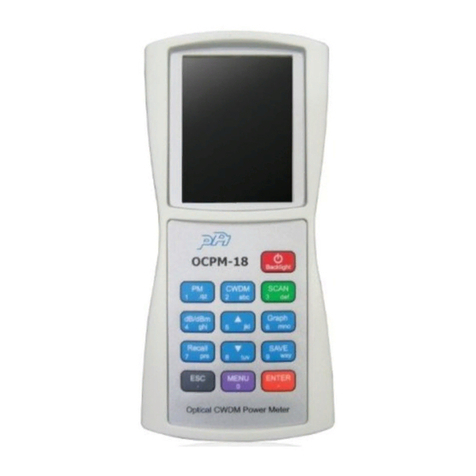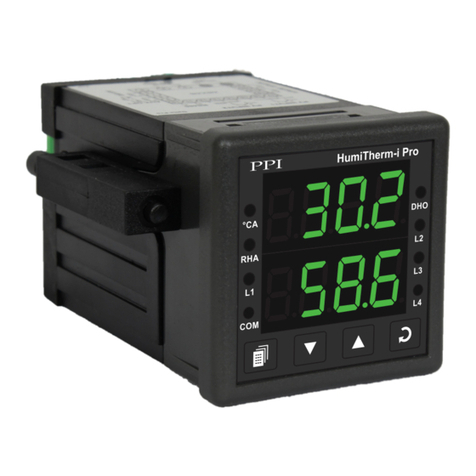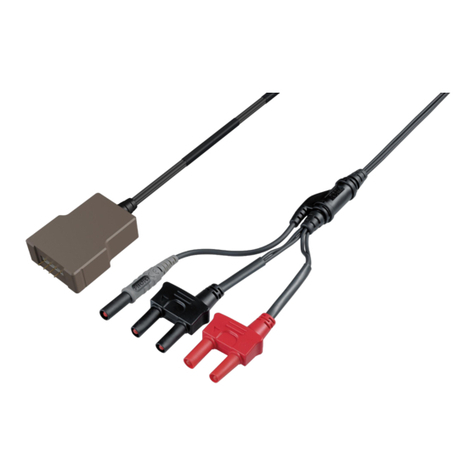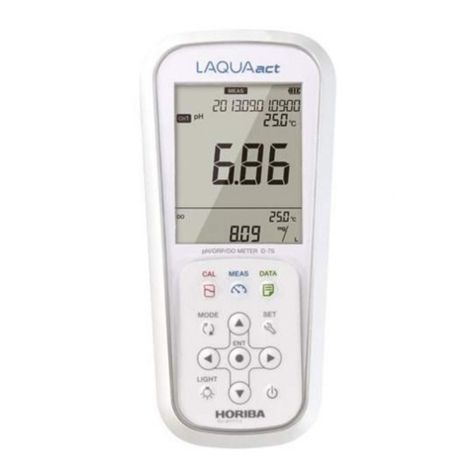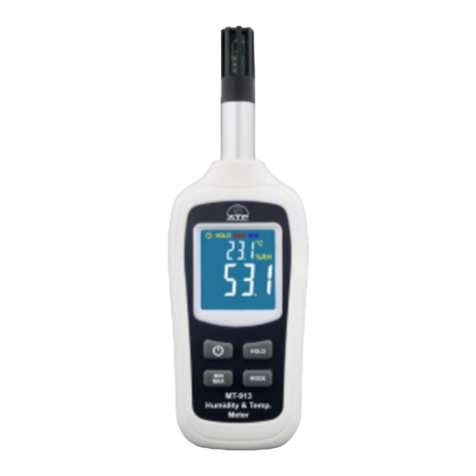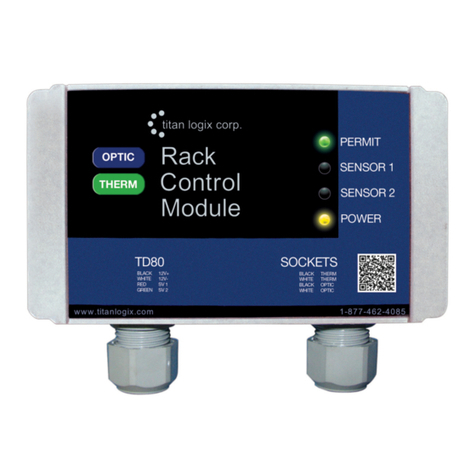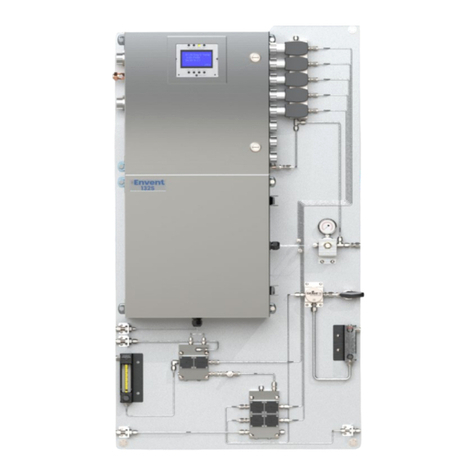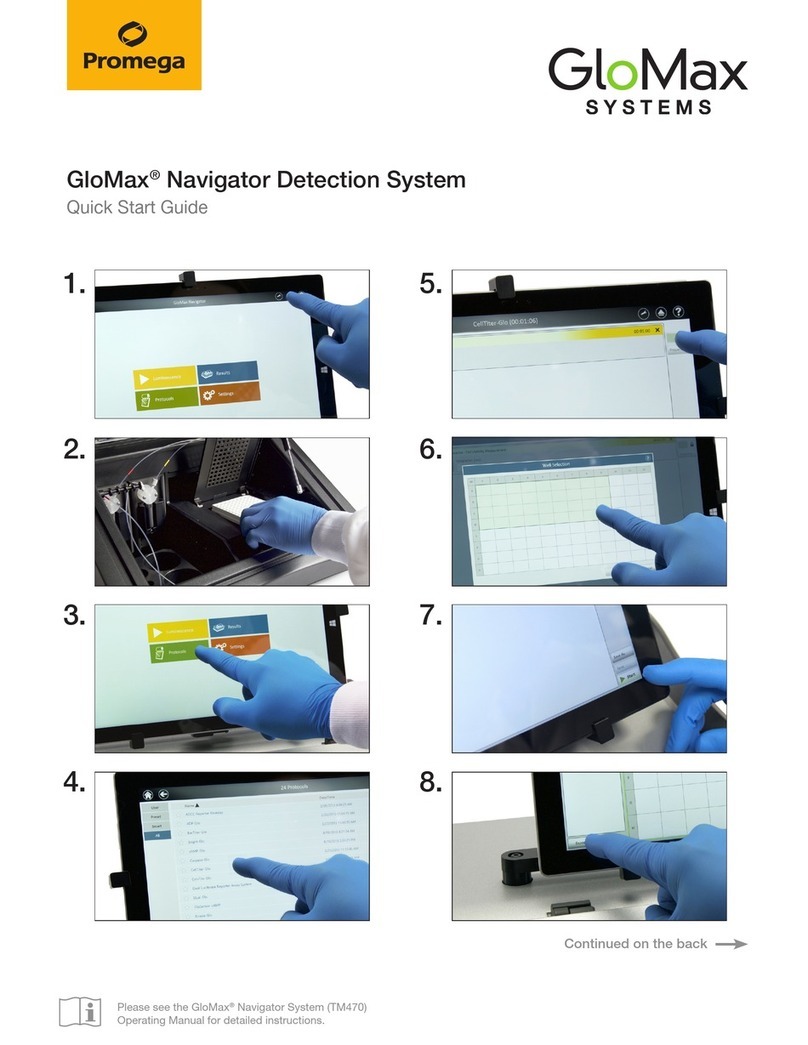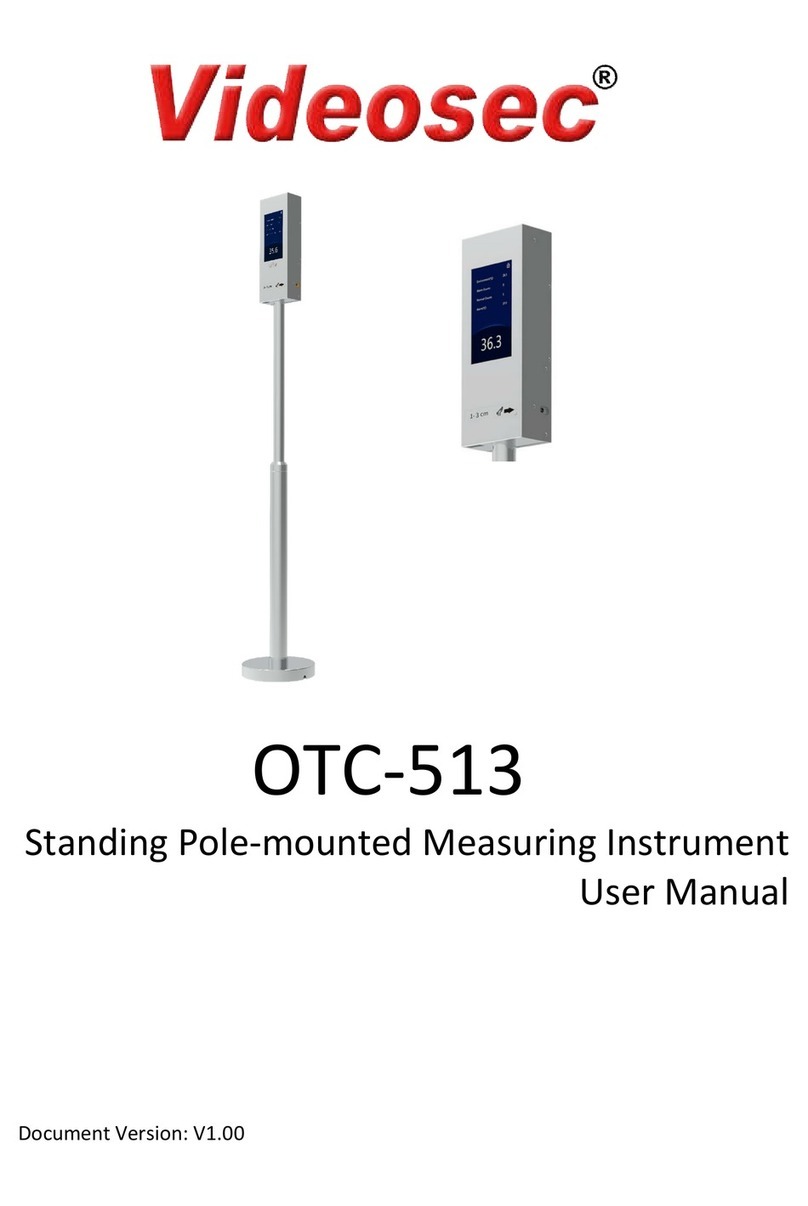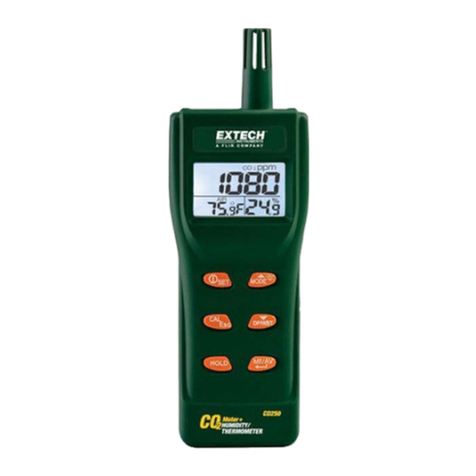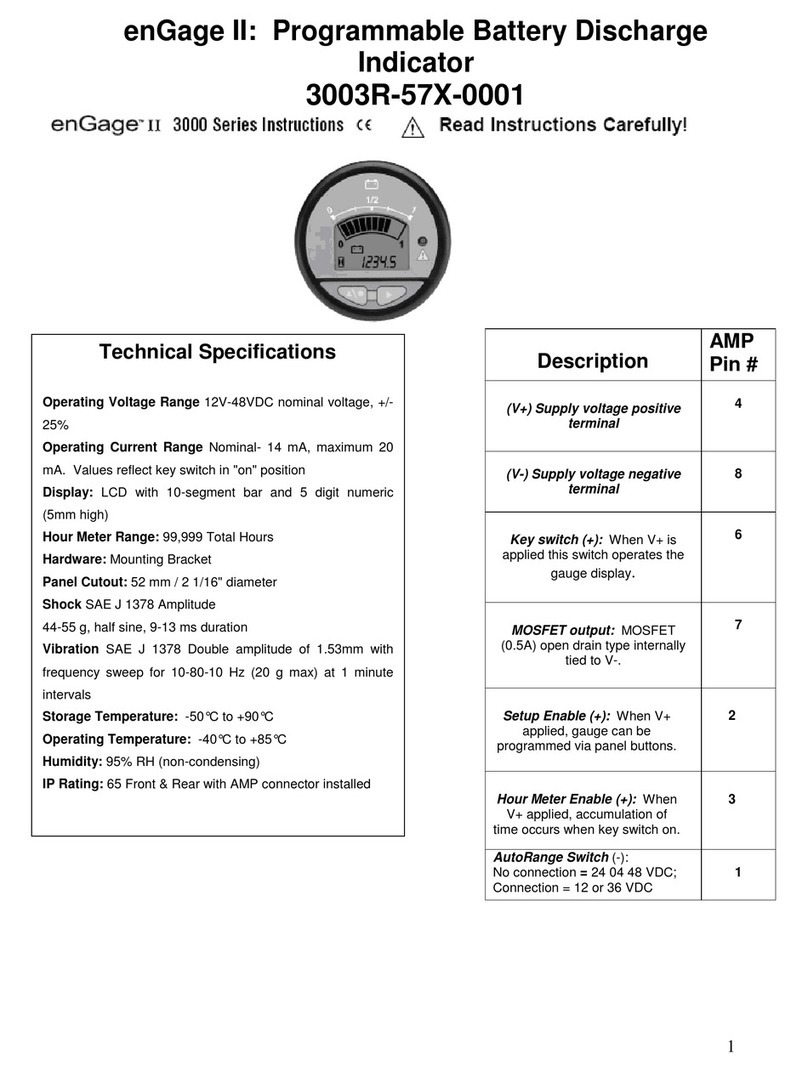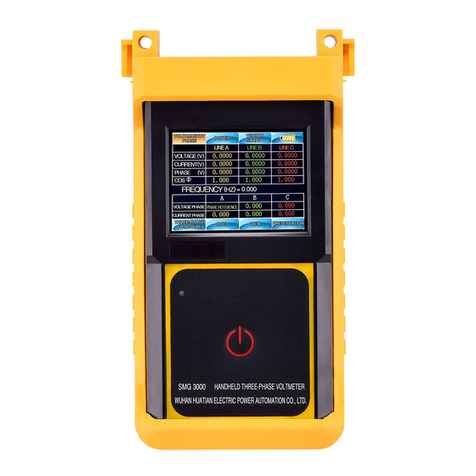PPI UPI-5D User manual

User Manual
UPI-5D
UPI-5D
User Manual
Universal Process Indicator
with Enhanced Features

User Manual
UPI-5D
CONTENTS
1. FRONT PANEL LAYOUT 1
2. BASIC OPERATION 3
3. SET-UP MODE ACCESS AND OPERATION 5
4. ALARM PARAMETERS 7
5. RETRANSMISSION PARAMETERS 9
6. INPUT CONFIGURATION 10
7. SUPERVISORY PARAMETERS 13
8. USER LINEARISATION PARAMETERS 15
9. MECHANICAL INSTALLATION 16
10. ELECTRICAL CONNECTIONS 18
APPENDIX-A : DC LINEAR SIGNAL INTERFACE 23

1
User Manual
UPI-5D
The indicator front panel comprises of digital readouts, LED indicators and membrane keys as shown in Figure 1.1(a) for New
Version & 1.1(b) for Old Version below.
FRONT PANEL LAYOUT
Figure 1.1(a) :
New Version
READOUTS
The Readout is a 5 digit, 7-segment bright red LED display and usually displays the PV (Process Value). In Set-up Mode, the
Readout displays parameter prompts and values/options, alternatively.
INDICATORS
The front panel comprises 2 LED indicators that show Alarm status. Refer Table 1.1 below for details.
Flashes while Alarm-1 is active.
AL1
AL2 Flashes while Alarm-2 is active.
LED Status
Table 1.1
Section 1
UPI - 5D
Readout
ENTER key
UP KeyPAGE Key
DOWN Key
AL1
AL2
Alarm 1 Indicator
Alarm 2 Indicator
ACK
UPI - 5D
AL-1
AL-2
ACK
Alarm 1 Indicator
Alarm 2 Indicator
ENTER key
UP Key
PAGE Key
DOWN Key
Readout
Figure 1.1(b) :
Old Version

2
User Manual
UPI-5D
KEYS
There are four tactile keys provided on the front panel for configuring the indicator, setting-up the parameter values. Refer
Table 1.2 below.
Table 1.2
Function
Symbol Key
DOWN
UP
PAGE Press to enter / exit Set-up mode.
Press to increase the parameter value. Pressing once
increases the value by one count; holding the key pressed
speeds up the change.
Press to decrease the parameter value. Pressing once
decreases the value by one count; holding the key pressed
speeds up the change.
ENTER
If Readout is showing Parameter Name in the setup mode then
upon pressing this key the Readout shows the value for the
parameter.
If Readout is showing Parameter Value in the setup mode then
upon pressing this key the set parameter value is stored and
the Readout shows the next Parameter Name.
Note : While in Main mode, this key can be used to
acknowledge any pending Alarm(s) to de-activate alarm
relay(s).
ACK

3
User Manual
UPI-5D
PV Error Indications
The process value is said to be in error if it exceeds the minimum / maximum range specified for the selected Input sensor type
or if the sensor is disconnected (Open or Broken).The PV Error type, as shown in Table 2.1, is flashed on the Readout.
Table 2.1
PV above Max. Range
PV below Min. Range
Message Error Type Cause
Thermocouple / RTD broken
Sensor Open
Under-range
Over-range
BASIC OPERATION
ALARM STATUS UNDER PV ERROR CONDITIONS
For Alarm activation, the under-range condition is treated as minimum PV, whereas the over-range and open conditions are
treated as maximum PV. Thus, Process High alarm activates under Over-range / Open error. Similarly, Process Low alarm
activates under Under-range error.
Alarm Acknowledgment
While in Main mode, press ENTER Key to acknowledge any pending Alarm(s) to de-activate alarm relay(s).
OPERATOR PAGE AND PARAMETERS
The parameters that require frequent settings are organized on a separate page, called the Operator Page. The availability of
operator parameters is controlled at supervisory level and the parameter setting cannot be locked by the Master Lock.
Accessing Operator Page & Adjusting Parameters
Step through the following sequence to open the operator page and to adjust the operator parameter values.
1. Press and release PAGE key. The Readout shows PAGE. Press and release PAGE key again. The Readout shows page
number 0.
2. Press and release ENTER key. The Readout shows prompt for the first available operator parameter. Press and release
ENTER key again. The Readout shows value for the first parameter.
3. Use UP / DOWN keys to adjust the value and then press ENTER key to store the set value and scroll to the next parameter.
The indicator automatically reverts to MAIN Display Mode upon scrolling through the last operator parameter. Alternatively,
use PAGE key to return to MAIN Display Mode.
Section 2
POWER UP
Upon switching on the power to the indicator, all displays are lit on for approximately 3 seconds. This is followed by the
indication of the model name and Version Number for 1 second each.
MAIN DISPLAY
After the Power-up display sequence, the Indicator enters MAIN Display Mode. The Readout shows the measured PV
(Process Value).

4
User Manual
UPI-5D
Table 2.2
Parameter Description Settings
(Default Value)
View Only
(Default :NA)
View Only
(Default :NA)
0 to 250
(Default :0)
Min to max Range
specified for the
selected Input Type
(Default : Min or Max Range)
MAXIMUM PV
This indicates the highest value attained by the Process Value.
This is a read only value and is available only if Min/Max
monitoring is enabled.
MINIMUM PV
This indicates the lowest value attained by the Process Value.
This is a read only value and is available only if Min/Max
monitoring is enabled.
RESET COMMAND
Available only if Min/Max monitoring is enabled. This feature
clears the current Min/Max values and starts afresh monitoring the
PV for new highest and lowest values.
RESET PASSWORD
For resetting the Min/Max values, set the reset command to ‘Yes’
and then enter the correct password.
ALARM-1 SETPOINT
The setpoint for Alarm-1. This parameter is not available if the
selected Alarm-1 type is ‘None’.
ALARM-2 SETPOINT
The setpoint for Alarm-2. This parameter is not available if the
selected Alarm-2 type is ‘None’.
Min to max Range
specified for the
selected Input Type
(Default : Min or Max Range)
(Default :No)
No
Yes
The operator parameters are described in Table 2.2. Note that the parameters presented on Operator Page depend upon the
functions selected/enabled and supervisory level permissions. The operator parameter list mainly includes :
a) Min / Max Process Monitoring Parameters.
b) Setpoint Values for Alarm-1 and Alarm-2.

5
User Manual
UPI-5D
SET-UP MODE : ACCESS AND OPERATION
Figure 3.1
Section 3
Press PAGE
key to enter
Set-up mode
Use UP/DOWN
keys to set the
Desired Page Number
MAIN Display
Mode
Readout
shows ‘PAGE’
Default Page
Number
(Operator Page)
or
Desired Page
Number
Press ENTER
key to open
the Page
Press ENTER
key to open
the Page
The requires various user settings that determine how the indicator will function or operate. These settings are called Indicator
Parameters.
For the convenience and ease of operation, the various parameters have been grouped separately depending upon the
functions they define. Each such group is called a PAGE. Each PAGE is assigned a unique number, called PAGE NUMBER,
for its access. The parameters contained in a PAGE are presented in a fixed sequence to the user for setting. The user can
access a desired PAGE by entering its PAGE NUMBER and can select and set the desired parameter values.
PARAMETER SNAME
Each parameter has an identifying tag, called the Parameter . While setting parameter values in a PAGE, the arameter Name P
Name P precedes the arameter Value.
While the r adout shows Parameter Name, the UP DOWN keys are non-functional. pon pressing the key the e / U ENTER
readout shows the arameter Value that can be adjusted using UP / DOWN keys.P
ACCESSING A PAGE & ADJUSTING PARAMETER VALUES
Each PAGE is accessible only from the MAIN Display Mode. That is, from the current PAGE, the user must return to the MAIN
Display Mode before the other PAGE can be accessed.
Step through the following sequence to open PAGE and to adjust the parameter values.a desired
1. Press and release PAGE key. The eadout shows . R PAGE
2. Press and release ENTER key. The Readout shows , the default page value. 0
3. Use UP/DOWN keys to set the desired PAGE NUMBER.
4. Press and release ENTER key. The Readout shows Name for the first available parameter under the selected page
number.
5 . Press and release ENTER key. The Readout shows value for the first parameter.
6 Go to step 8 if the value for first parameter is to be edited..
7. Press & release Enter Key until the readout shows the name for the desired parameter.
8. Use UP / DOWN keys to adjust the value and then press ENTER key to store the set value and scroll to the next parameter.
9 7. Go to step .
The indicator automatically reverts to MAIN Display Mode upon scrolling through the last parameter. Alternatively, use PAGE
key to return to MAIN Display Mode.
Figure 3.1 illustrates the example of altering the value for the parameter ‘Input Type’ from ype .T K Thermocouple to 4-20 mA

6
User Manual
UPI-5D
Notes
1. Each page contains a fixed list of parameters that are presented in a pre-determined sequence. Note however that availability of a few
parameters, called Conditional Parameters, depend upon the settings for some other parameters. For example, the parameter ‘Alarm
Setpoint’ is if the corresponding ‘Alarm type’ is set to ‘ ’. not available none
2. To exit the set-up mode and return to the MAIN Display Mode, press and release PAGE key.
3. If no key is pressed for approximately 30 seconds, the set-up mode times out and the indicator reverts to the MAIN Display Mode.
MASTER LOCKING
The indicator facilitates locking all the PAGES (except Operator PAGE) by applying Master Lock Code. Under Locking, the
parameters are available for and cannot be adjusted. The Master Lock, however, does not lock the operator view only
parameters. This feature allows protecting the rather less frequently used parameters against any inadvertent changes while
making the frequently used operator parameters still available for any editing.
For enabling / disabling the Lock, step through the following sequence:
Locking
1. Press and release PAGE key while the indicator is in the MAIN Display Mode. The Readout shows PAGE.
2. Press and release ENTER key the Readout shows page number 0
3. Use UP / DOWN keys to set the Page Number to 123 on the Readout.
4. Press and release ENTER key. The indicator returns to the MAIN Display Mode with the Lock enabled.
The Figure 3.2 below illustrates the Locking procedure.
Figure 3.2
UnLocking
Repeat the Locking procedure twice for unlocking.
Press ENTER
key to enter
Set-up mode
Use UP/DOWN
keys to set the
‘Locking’ Code
Press ENTER key
to Lock & Return
to MAIN Mode
Readout
shows ‘PAGE’
MAIN Mode
Default Page
Number
Locking Code
or
Press PAGE
key to enter
Set-up mode
MAIN Mode
Current
Input type
New Value Next
Parameter Name
Use UP/DOWN
keys to set the
New Value
or
First Parameter
on PAGE-12
Press ENTER
key to access
parameter value
Press ENTER key
to store the value & move
to next Parameter Name

7
User Manual
UPI-5D
Visit www.ppiindia.net for technical notes on ALARM for detailed understanding of the parameters / terminologies
used for describing the Alarm parameters in this section.
The parameters required for configuring Alarms are grouped on PAGE-10. The configuration includes selecting the type of
Alarm, setting the hysteresis value, enabling/disabling start-up Alarm suppression, etc. Refer Table 4.1 for parameter
description & settings.
ALARM PARAMETERS : PAGE-10
Table:4.1
Parameter Description Settings
(Default Value)
None
Process Low
Process High
(Default : None)
Min. to Max. Range
specified for the
selected Input Type
(Default : Min or Max Range)
For DC Lin. Volts/Current
1 to 30000 Counts
For Thermocouple/RTD
1 to 3000 or 0.1 to 3000.0
(Default : 2.0)
ALARM-1 TYPE
Select the Alarm-1 activation type. Selecting ‘None’ will disable
the alarm and suppress all the related parameters for Alarm-1.
ALARM-1 SETPOINT
Sets the Process High or Process Low limit for Alarm-1.
ALARM-1 HYSTERESIS
Sets differential (dead) band between Alarm-1 ON and OFF
states.
ALARM-1 INHIBIT
Set to Yes to suppress Alarm-1 activation upon power-up (process
start-up) condition.
ALARM-1 LOGIC
Select ‘Normal’ if Alarm-1 relay is to activate an Audio / Visual
alarm. Select ‘Reverse’ for Tripping (cut-off) the system.
ALARM-1 LATCH
No
The Relay switches ON/OFF with Alarm switching.
Yes
The Relay Output switches (ON for Normal Logic / OFF for
Reverse Logic) upon Alarm activation. However, Alarm de-
activation does not affect the Relay status. The Relay status can
only be regained by pressing ‘Acknowledge-key’ provided the
Alarm has de-activated.
Section 4
(Default :No)
No
Yes
(Default :No)
No
Yes
(Default : Normal)
Reverse
Normal

8
User Manual
UPI-5D
Parameter Description Settings
(Default Value)
(Default : Normal)
Reverse
Normal
Min. to Max. Range
specified for the
selected Input Type
(Default : Min/Max Range)
Sets the Process High or Process Low limit for Alarm-2.
ALARM-2 SETPOINT
Sets differential (dead) band between Alarm-2 ON and OFF
states.
ALARM-2 HYSTERESIS
Set to Yes to suppress Alarm-2 activation upon power-up (process
start-up) condition.
ALARM-2 INHIBIT
Select ‘Normal’ if Alarm-2 relay is to activate an Audio / Visual
alarm. Select ‘Reverse’ for tripping (cut-off) the system.
ALARM-2 LOGIC
ALARM-2 TYPE
Select the Alarm-2 activation type. Selecting ‘None’ will disable
the alarm and suppress all the related parameters for Alarm-2.
No
The Relay switches ON/OFF with Alarm switching.
Yes
The Relay Output switches (ON for Normal Logic / OFF for
Reverse Logic) upon Alarm activation. However, Alarm de-
activation does not affect the Relay status. The Relay status can
only be regained by pressing ‘Acknowledge-key’ provided the
Alarm has de-activated.
ALARM-2 LATCH
(Default :No)
No
Yes
(Default :No)
No
Yes
For DC Lin. Volts/Current
1 to 30000 Counts
For Thermocouple/RTD
1 to 3000 or 0.1 to 3000.0
(Default : 2.0)
None
Process Low
Process High
(Default : None)

9
User Manual
UPI-5D
The parameters required for configuring Retransmission are grouped on PAGE-11. The configuration includes selecting the
Output type, Recorder Low & High settings etc. Refer Table 5.1 for parameter description & settings.
RETRANSMISSION PARAMETERS : PAGE-11
Table 5.1
Parameter Description Settings
(Default Value)
Min. to Max. Range
specified for the
selected Input Type
(Default : -200.0)
Select Output Signal type in accordance with the hardware
module fitted. Select 0-20 or 4-20 mA, if Current output module is
fitted. Select 0-5 or 0-10 V, if Voltage output module is fitted.
RETRANSMISSION (RECORDER)
OUTPUT TYPE
Set the minimum Process Value (PV) that shall correspond to the
minimum recorder output signal level (0mA or 4mA or 0V).
RETRANSMISSION (RECORDER) LOW
Set the maximum Process Value (PV) that shall correspond to the
maximum recorder output signal level (20 mA or 10 V or 5 V).
RETRANSMISSION (RECORDER) HIGH
(Default : 0 to 20 mA)
0 to 20 mA
4 to 20 mA
0 to 5 Volts
0 to 10 Volts
Min. to Max. Range
specified for the
selected Input Type
(Default : 1376.0)
Section 5

10
User Manual
UPI-5D
INPUT CONFIGURATION PARAMETERS : PAGE-12
Section 6
Table 6.1
Parameter Description Settings
(Default Value)
Refer Table 6.2
(Default : Type K)
Refer Table 6.2
(Default : 1°C)
°C
°F
(Default : °C)
Select Input type in accordance with the type of Thermocouple or
RTD sensor or transducer output connected for process value
measurement.
Note : The Thermocouple & RTD Pt100 Inputs are not available if
the Square Root selection is set to ‘Yes’.
INPUT TYPE
Set the process value indication resolution (decimal point). All the
resolution based parameters (hysteresis, alarm setpoints etc.)
then follow this resolution setting.
RESOLUTION
(Applicable for Thermocouple & RTD Pt100 Input only)
Select Temperature units in °C or °F.
UNITS
DC SIGNAL LOW
(Available for DC Linear Input)
This parameter is the transmitter output signal value that
corresponds to the Range Low process value. Refer Appendix-A :
DC Linear Signal Interface for details.
(Default :No)
No
Yes
SQUARE ROOT SELECTION
Set this parameter value to ‘Yes’ if the Square Root Extraction
function is required for Flow Rate measurement.
1
0.1
0.01
0.001
(Default : 1)
CONST MULTIPLIER RESOLUTION
(Available if Square root is set to ‘Yes’)
This parameter sets the decimal position (resolution) for the
parameter Constant Multiplier.
1 to 9999
(Default : 0)
CONST MULTIPLIER
(Available if Square root is set to ‘Yes’)
This parameter is multiplied with square root extracted value to
derive the flow rate. The resolution for this parameter is set by the
parameter Constant Multiplier resolution.
Input Type Settings Default
0 to 20 mA
4 to 20 mA
0 to 5 V
0 to 10 V
1 to 5 V
0.00 to Signal High
4.00 to Signal High
0.000 to Signal High
0.00 to Signal High
1.000 to Signal High
0.00
4.00
0.000
0.00
1.000
0 to 80m V 0.00 to Signal High 0.00

11
User Manual
UPI-5D
Parameter Description Settings
(Default Value)
DIGITAL FILTER
Sets the time constant, in seconds, for the low-pass digital filter
applied to the measured PV. The filter helps smoothing /
averaging the signal input and removing the undesired noise. The
higher the filter value the lower the indication response to the PV
changes and vice-a-versa.
0.5 to 60.0 Seconds
(in steps of 0.5 Seconds)
(Default : 2.0 sec.)
For DC Lin. Volts/Current
-19999 to 30000 Counts
For Thermocouple/RTD
-1999 to 3000 or
-1999.9 to 3000.0
(Default : 0)
This value is algebraically added to the measured PV to derive the
final PV that is displayed and used for Alarm / Retransmission.
Final PV = Measured PV + Offset
OFFSET
-19999 to 30000
(Default : 100.0)
(Available for DC Linear Input)
Sets process value corresponding to maximum DC Linear signal
input (e.g., 5V, 10V, 20mA, etc.)
DC RANGE HIGH
-19999 to 30000
(Default : 0.0)
DC RANGE LOW
(Available for DC Linear Input)
Sets process value corresponding to minimum DC Linear signal
input (e.g., 0V, 0mA, 4mA, etc.)
(Available for DC Linear Input)
This parameter is the transmitter output signal value that
corresponds to the Range High process value. Refer Appendix-A :
DC Linear Signal Interface for details.
DC SIGNAL HIGH Input Type Settings Default
0 to 20 mA
4 to 20 mA
0 to 5 V
0 to 10 V
1 to 5 V
20.00
20.00
5.000
10.00
5.000
Signal Low to 20.00
Signal Low to 20.00
Signal Low to 5.000
Signal Low to 10.00
Signal Low to 5.000
0 to 80 mV 80.00
Signal Low to 80.00

12
User Manual
UPI-5D
Table 6.2
-19999 to 30000 units
1
0.1
0.01
0.001
units
0 to 20mA DC current
4 to 20mA DC current
0 to 80mV DC voltage
0 to 1.25V DC voltage
0 to 5.0V DC voltage
0 to 10.0V DC voltage
1 to 5.0V DC voltage
3-wire, RTD Pt100
1 °C/°F
or
0.1 °C/°F
-199.9 to +600.0°C / -328.0 to +1112.0°F
Resolution
Option What it means Range (Min. to Max.)
Type K Thermocouple
Type T Thermocouple
Type N Thermocouple
Type R Thermocouple
Type S Thermocouple
Type B Thermocouple
Reserved for customer specific Thermocouple type not listed above.
The type shall be specified in accordance with the ordered (optional
on request) Thermocouple type.
0.0 to +1314.0°C / +32.0 to +2397.0°F
0.0 to +1826.0°C / +32.0 to +3218.0°F
0.0 to +1768.0°C / +32.0 to +3214.0°F
0.0 to +1771.0°C / +32.0 to +3219.0°F
-200.0 to +387.0°C / -328.0 to +728.0°F
-200.0 to +1376.0°C / -328.0 to +2508.0°F
0.0 to +960.0°C / +32.0 to +1760.0°F
Type J Thermocouple
1 °C/°F
or
0.1 °C/°F
Reserve

13
User Manual
UPI-5D
Supervisory permission for enabling recorder (retransmission)
output.
RECORDER
Supervisory permission for use of the rear panel terminals for
connecting remote switch for Alarm acknowledgment.
REMOTE ALARM ACKNOWLEDGE SWITCH
SUPERVISORY PARAMETERS : PAGE-13
Section 7
Table 7.1
Parameter Description Settings
(Default Value)
0 to 250
(Default : 0)
(Default : 9.6)
4800
9600
19200
38400
57600
ALARM SP ADJUSTMENT
ON OPERATOR PAGE
Supervisory permission for Alarm setpoint adjustments on
Operator Page. Set to ‘Enable’ for permission.
PROCESS VALUE HIGH-LOW MONITORING
This parameter enables or disables the PV monitoring for Min /
Max values. Set to ‘Yes’ for enabling the feature.
This parameter allows protection against inadvertent resetting of
Min / Max values. That is, the reset command is executed only if
the operator sets the password that matches with this parameter
value.
PASSWORD FOR RESETTING
PV HIGH-LOW
BAUD RATE
Communication speed in ‘Bits per Second’. Set the value to match
with the host baud rate.
PARITY
One of the communication error trapping features. Select the data
packet parity as implemented by the host protocol.
(Default : Even)
None
Odd
Even
(Default : Disable)
Disable
Enable
(Default :No)
No
Yes
(Default : Disable)
Disable
Enable
(Default : Disable)
Disable
Enable

14
User Manual
UPI-5D
Parameter Description Settings
(Default Value)
1 to 127
(Default : 1)
SERIAL ID NUMBER
Unique numeric code assigned to the indicator for identification by
the host. Set the value as required by the host.
SERIAL WRITE PERMISSION
Setting to ‘No’ disallows the host to set / modify any parameter
value. The host, however, can read the value. (Default :No)
No
Yes

15
User Manual
UPI-5D
Visit www.ppiindia.net for technical notes on USER LINEARISATION for detailed understanding of the parameters /
terminologies used for describing the parameters in this section.
The parameters listed on this page are used to implement the linearisation curve on the process value represented by the DC
linear output of a transmitter. The parameters affect the measured PV only if the ‘User Linearisation’ feature is ‘Enabled’ and if
the input type is DC Linear. That is, the PV measured using Thermocouple or RTD is not affected by the linearisation
parameters. The Table 8.1 below lists the user linearisation parameters.
USER LINEARISATION PARAMETERS : PAGE-33
Table 8.1
Parameter Description Settings
(Default Value)
0 to 9999
(Default : 0)
2 to 32
(Default : 2)
1 to 32
(Default : 1)
-19999 to 30000
(Default : Undefined)
USER LINEARIZATION SETTING CODE
Protection password for access to the linearisation related
parameters. Set to 333 as valid password.
USER LINEARIZATION
Enable / Disable user linearisation feature.
TOTAL BREAK POINTS
Select number of segments for the purpose of input PV curve
linearisation by setting the number of total break points.
BREAK POINT NUMBER
Select the break point for which the X, Y co-ordinates are to be set.
Set the actual measured (X co-ordinate) value for the selected
break point number.
ACTUAL VALUE FOR
BREAK POINT (X CO-ORD)
DERIVED VALUE FOR
BREAK POINT (Y CO-ORD)
Set the computed or derived (Y co-ordinate) value for the selected
break point number.
-19999 to 30000
(Default : Undefined)
Section 8
(Default :No)
No
Yes

16
User Manual
UPI-5D
The following precautions should be strictly observed while installing the indicator:
1. The place of installation should be free of corrosive/combustible gases and electrically conductive pollution.
2. Ensure that the place of installation is not subject to rapid ambient changes that can cause condensation. Also the Ambient
Temperature and Relative Humidity surrounding the indicator should not exceed the maximum specified for the proper
operation of the Indicator.
3. The place of installation should be adequately protected against excessive electrostatic or electromagnetic interference.
4. The Indicator should not be subject to direct vibration or shock.
5. The Indicator should not be exposed to dust, salt air, direct sunlight or radiant heat.
OUTER DIMENSIONS
The Figure .1(a), 9.1(b) & 9.1(c) show the outer dimensions for the & ( ), 9 Version 3 (Latest), Version 2 Version 1 Oldest
respectively.
MECHANICAL INSTALLATION
Figure 9.1(b) :
Version 2
Section 9
96 mm
48 mm
Front View
UPI - 5D
AL1
AL2
ACK
Side View
75 mm
Figure 9.1(c) :
Version 1
(Oldest)
Side View
73 mm
UPI - 5D
AL-1
AL-2
ACK
48 mm
96.5 mm
Front View
Figure 9.1(a) :
Version 3
(Latest)
UPI - 5D
AL-1
AL-2
ACK
48 mm
96.5 mm
Front View
Side View
82 mm
10 mm

17
User Manual
UPI-5D
PANEL MOUNTING
Follow the steps below for mounting the Indicator on panel:
1. Prepare a gular cutout to the size shown in Figure .2. ractan 9
2. Remove the Panel Mounting Clamp from the Indicator Enclosure.
3. Insert the rear of the Indicator housing through the panel cutout from the front of the mounting panel.
4. Hold the Indicator gently against the mounting panel such that it positions against the panel wall, see Figure .3. correctly 9
Apply pressure only on the bezel and not on the front label.
5. Insert the clamps on either side of the enclosure in the provided and slide th grooves em forward until this are firmly in
contact with the rear face of the mounting panel. Refer Figure 9.3 below.
Figure 9.3
Clamps
Mounting Panel with
Square Cutout
Groove for
Mounting Clamp
PANEL CUTOUT AND RECOMMENDED MINIMUM SPACING
The Figure .2 shows 9 Version 3 (Latest ), Version 2 & Version 1
(Oldest) panel cutout requirements for a single Indicator and also
the minimum spacing recommended if several Indicators are
required to be mounted on a single panel.
Panel Cutout
44 X 90 mm
-0, +0.5 mm
(1.73 X 3.54 in)
(-0, +0.02 in)
10mm (0.39in)
38mm (1.5in)
Panel Cutout
45 X 92 mm
-0, +0.5 mm
(1.77 X 3.62 in)
(-0, +0.02 in)
Version 3
&
Version 2
Version 1
Figure 9.2

18
User Manual
UPI-5D
WARNING
MISHANDLING / NEGLIGENCE CAN RESULT IN
PERSONAL DEATH OR SERIOUS INJURY.
WARNING
MISHANDLING / NEGLIGENCE CAN
RESULT IN PERSONAL DEATH OR
SERIOUS INJURY.
ELECTRICAL CONNECTIONS
1. The user must rigidly observe the Local Electrical Regulations.
2. Do not make any connections to the unused terminals for making a tie-point for other wires (or for any other reasons) as
they may have some internal connections. Failing to observe this may result in permanent damage to the indicator.
3. Run power supply cables separated from the low-level signal cables (like Thermocouple, RTD, DC Linear Current/Voltage,
etc.). If the cables are run through conduits, use separate conduits for power supply cable and low-level signal cables.
4. Use appropriate fuses and switches, wherever necessary, for driving the high voltage loads to protect the indicator from
any possible damage due to high voltage surges of extended duration or short-circuits on loads.
5. Take care not to over-tighten the terminal screws while making connections.
6. Make sure that the Indicator supply is switched-off while making/removing any connections or removing the from Indicator
its enclosure.
CONNECTION DIAGRAM
The Electrical Connection Diagram is shown on the top side of the enclosure. The diagram shows the terminals Indicator
viewed from the REAR SIDE with the label upright. Refer the label provided on the Indicator Rear Side for terminal numbers.
Note that a few connections are functional / applicable only if the respective plug-in modules are fitted.
The rear panel electrical wiring connection diagram is shown in Figure1 .1(a), 10.1(b) & 10.1(c) for 0 Version 3 (Latest),
Version 2 & Version 1 (Oldest) below.
Figure 10.1(a):
Version 3 (Latest)
Section 10
PPI
UPI-5D
1 2 3456 7 8 9 10
11 12 13 14 15 16 17 18 19 20
Excitation
Output
Alarm
ACK
+
–
24 VDC
Retrans
Output
NC C NO
RELAY
+
–
*SSR
NC C NO
RELAY
+
–
B+ B-
RS485 Serial
PV Input
mA
V / mV
TC
RTD
+
–
+ +
mA / V
+
–
85 ~ 265
VAC *SSR
Alarm 2Alarm 1
Supply
Available on Request
*
–
–
NL
PPI
B127-V1
UPI-5D
85~265
VAC
Supply
*Available
on Request
17 18 19 20 21 22
B+ B-
24V
mA
mV
TC
RTD
+ + +
–
–
–
mA/V
+
–
–
+
V
1 2 3456 7 8 9 10 11 12 13 14
NL
15 16
PV Input
ALM
ack
RS485 Retrans
NC C NO
RELAY
+
–
*SSR
ALM 1
NC C NO
RELAY
+
–
*SSR
ALM 2
Exc
O/P
Figure 10.1(c):
Version 1 (Oldest)
Figure 10.1(b):
Version 2
UPI-5D
B+ B-
mA
mV
TC
RTD
+ + +
–
–
–
mA/V
+
–
–
+
V
PV Input
RS485 Retrans
24V
Exc
O/P
1 2 3456 7 8 9 10 11 12 13 14
19 20 21 22 23 24 25 26
NC C NO
RELAY
+
–
SSR
ALM 1
15 16 17 18
85~265
VAC
Supply
N
LNC C NO
RELAY
+
–
SSR
ALM 2
ALM ACK
mA
V
RLY
SSR
Retrans ALM 2
RLY
SSR
ALM 1
Table of contents
Other PPI Measuring Instrument manuals

